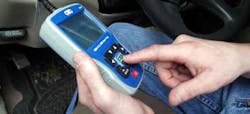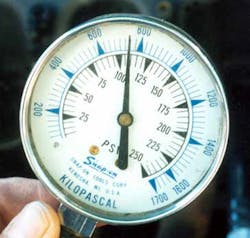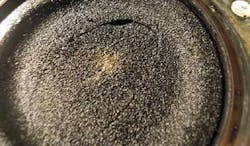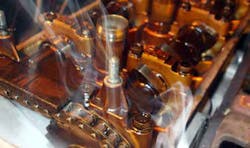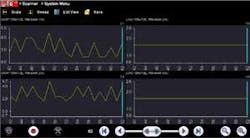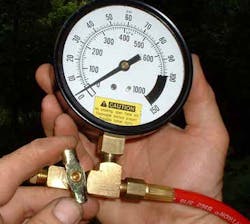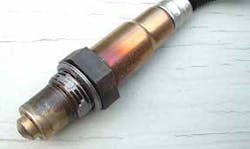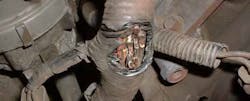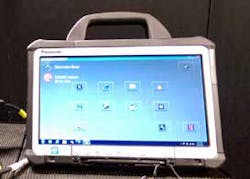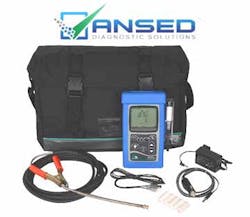Technicians tend to malign DTCs (Diagnostic Trouble Codes) as misleading and unreliable. Paradoxically, it’s a rare service personage who doesn’t use them early on in any driveability troubleshooting effort. Admit it: Pulling codes is an easy and fast way to launch the expedition to find that elusive trouble.
So how about those cases -- and there are many -- in which no codes are present? Where do you start? Easy -- with the basics. We can pretty well imagine you sitting there rolling your eyes and thinking, “How many times have I heard that before?” And well you should hear it. Most authorities from service training instructors to aftermarket engineers agree that skipping the basics is the most prevalent cause of misdiagnosis and of perfectly good parts being returned as defective.
As a manager for one of the major tech hotlines tells us, “I really agree with Ford’s stated philosophy. In its manuals, it’ll say something like, ‘Caution: The following non EEC (Electronic Engine Control) areas may be the cause of the problem,’ and, ‘Stop! Think! Why are you checking the EEC system?’ From our experience on the hotline, the best thing to do is to go back to step one the basics.”
Just cause
A brief look at the rationale behind OBD II (and even ancient- history OBD I) systems will help you understand why they don’t always work as you might expect them to. As you are perhaps painfully well aware, most of the complications in modern cars are ultimately the result of two momentous challenges to our complacent society: air pollution and the energy crunch. The most logical and straightforward way to clean up engine exhaust and increase fuel efficiency was to enlist electronic engine management.
So, we got environmentally-friendly, great-performing vehicles that turned in impressive mpg, but at the cost of complexity that sometimes seems to approach that of the space shuttle. Engineers and auto execs know that if a car gets a reputation as troublesome and difficult to fix, it’ll be hard to sell another one, which made improving the chances of success in diagnosis a high priority with them.
One way to do that was to enlist the help of an “intelligence” that was already on board: the engine management computer (known in universal SAE J-1930 jargon as the PCM -- “Powertrain Control Module”). It “knows” all the proper operating parameters and specifications of the vehicle it manages, so adding a diagnostic program to its little cranium makes sense. The programming itself is not so simple, however, nor is the means of communicating its findings. Some problems will turn on the MIL (Malfunction Indicator Lamp), others won’t.
Eventually, all the automakers adopted the idea of using codes to tell us what, if anything, the computer has recognized as out of range or otherwise improper. Armed with the specific list of what the codes refer to (which became standardized and much more comprehensive under OBD II, but that whole subject is fodder for another article), you’ll get a pretty good idea of which system or circuit to start investigating more deeply.
Triggers
The PCM’s OBD (On-Board Diagnostic) program monitors the signals received from the sensor network and compares them to the standards that are recorded in permanent memory. If they’re out of their specified range or missing entirely for a calibrated amount of time, the OBD sets a code in RAM (Random Access Memory).
The program also looks for situations that don’t make sense. For instance, if the coolant temperature sensor continues to send a cold signal after the engine has been running for a while, the OBD will “think” it’s discovered a problem in the CTS circuit, so it’ll set the appropriate code (actually, a missing thermostat could be the trouble, which is an example of the limitations of self-diagnostics).
Then there’s comparison of the signals from two or more sensors. If, for example, the VSS (Vehicle Speed Sensor) is reporting to the computer that the car is at cruising speed, yet the TPS (Throttle Position Sensor) is sending a signal that indicates idle, and the MAP (Manifold Absolute Pressure) sensor doesn’t see the high vacuum of decel, a code may be set.
OBD watches actuator circuits, too, such as those that power the canister purge solenoid, AIC (Automatic Idle Control) motor, fuel injectors, etc. If there’s a short, open, high resistance, or other trouble present, you might get a code.
Blind spots
So much for what OBD can recognize. Now let’s look at some of the conditions to which it’s totally blind. To begin with, the PCM “assumes” that the engine can generate decent compression. If that doesn’t happen to be the case, the brain will send out inappropriate commands to the fuel injectors, ignition system, etc., commands that would make an engine with good internal components run properly, but just can’t fix a burned valve or a blown head gasket.
Or, suppose one fuel injector is clogged or otherwise inoperative. That cylinder will then pump enough plain air into the exhaust to make the oxygen sensor produce a lean signal. The computer, assuming that all the injectors are in great shape, will increase the pulse width command to every injector to enrich the air/fuel mixture and thus correct the lean condition. That’s not a helpful response since it’ll cause the other cylinders to run too rich.
The following is a list of some other problems that won’t set codes:
- Low fuel pressure and/or volume are big-time no-code troubles. Always check pressure, running and deadhead. Look at fuel trim numbers -- lean correction points to restriction. Also, read fuel pump amp draw, which will go up like crazy if the filter’s clogged.
- Heavy deposits on the backs of the valves can act like a sponge and soak up enough gasoline to cause lean running until they become saturated. The symptoms will appear after start up and before the engine becomes warm enough to enter closed loop. This won’t be detected by the OBD.
- Carboned-up throttle bores are causing more and more trouble. Check the automatic idle control percent or steps. Expect to see the idle air system trying to compensate, but don’t expect a code.
- Worn camshaft lobes that don’t allow a cylinder to fill may cause a dead miss at idle. OBD will be clueless.
- We’ve seen simple secondary ignition problems trigger fullbore computer system diagnosis efforts, and even engine replacement! Codes? Not a chance.
- A sluggish oxygen sensor can make a V6 feel as weak as a four, yet may not set a code.
- Speaking of low power, we remember a plugged catalytic converter that kept the top speed of a V8 cop car down to 40 mph, but nobody thought of that until major work had been done. No codes here, either.
- Malfunctions in mechanical emissions controls, such as PCV or air injection, won’t be recognized.
Helpful, yet not helpful
The simple facts are that OBD programs miss problems, direct you to a sensor when a wire or connection may be the real culprit, and simply can’t know whether an out-of-range situation is due to a sensor, the internal condition of the engine, or numerous other more subtle troubles. So, use codes when available, but don’t depend on them.
By the way, a common troubleshooting mistake is assuming that because no DTC is present, a particular sensor or its circuit is not the cause of the problem. If a symptom leads you to believe a component of the electronic engine management or EFI system isn’t doing its job properly, check it out even if no code’s been set.
Remember, the system can’t be designed to be trigger happy. If it were overly critical and too quick to register a fault, just the normal changing conditions every vehicle encounters would generate codes and cause the MIL to come on. So, self-diagnostics watch for patterns that typically represent problems and that exist for a calibrated length of time, not just one moment when a perfectly good sensor may go out of range because of dampness, a bump in the road, etc.
12-Step Program
With all that established, it’s time to get real practical and give you a sensible 12 step procedure:
Sure, you can shuffle the order of the steps according to the situation maybe you’ll want to take a looksee under the hood before your test drive. Just make sure you do all of them.
Engage Contents of Headbone
You can have the best scan tool, lab scope, or exhaust analyzer in the world in front of you presenting the clearest, most accurate data possible, and it won’t do you a bit of good unless you understand what it means in terms of how the engine runs.
Unfortunately, even long and hard-won experience won’t teach you very much if you don’t have a framework of understanding or “matrix” to put it in. We hope the following examples will contribute to the establishment of that framework by illustrating how data stream information can help you fix cars.
Suppose your shop is at sea level, but your scan tool shows a BARO reading of 78 kPa with the engine off. No DTCs are present, but you know that at your altitude barometric pressure should be close to 100 kPa (one bar, or 14.7 psi). It shouldn’t take much thought to realize that this faulty signal could cause lean running because the PCM will be supplying the proper amount of fuel for high elevations where there is less oxygen in each cubic unit of air, so the mixture will be lean at sea level.
Similarly, if you see a high resistance/low temperature reading from the intake/manifold air temperature sensor, yet the day is warm, you’ll know there’s trouble in the IAT/MAT sensor or its circuit because the information it’s providing simply doesn’t agree with current conditions even though the OBD system has not recognized that fact. This common-sense approach could also apply to a low temperature reading from the coolant temperature sensor when you can feel that the engine is hot.
Signals from mechanically-operated sensors can be checked against reality, too. Say you’re driving at cruising speed, yet the VSS registers 0 mph. Something’s obviously amiss. Or, maybe you see the at-idle voltage specification for TPS output even though you’ve put the pedal to the metal.
Besides comparing data stream information to actual conditions, you can compare it to what other sensors are telling you. For example, suppose when you open the throttle half way your scan tool tells you that the throttle angle is 50 percent, yet when you switch to the throttle position sensor voltage you get a reading of 1.2 volts. Since the reading should be around five volts at WOT (Wide Open Throttle), half throttle should be between two and three volts. By making an intelligent comparison, you’ve probably located the cause of a hesitation problem.
Another way to make good use of the data stream is to cause artificial conditions and see how the computerized engine management system responds. For instance, if you introduce a large vacuum leak (say, by removing the brake booster vacuum hose), you should see a lean flag, then an increase in fuel injector pulse width milliseconds. If you cause a rich condition (in the days of carburetors, you could close the choke plate; with EFI, you can pinch off the vacuum line to the fuel pressure regulator), you should see a rich flag, then a decrease in pulse width.
With an ordinary NTC CTS (Negative Temperature Coefficient Coolant Temperature Sensor), if you disconnect the sensor’s lead you should expect to see a very low temperature reading in the data stream. Grounding the lead should give you a high temperature indication. If you get these results, it is probable that the CTS circuit and the PCM are both okay. The trouble, then, is probably in the sensor itself, or deposits that keep it from warming up as it should.
Information provided by: Ansed Diagnostic Solutions
About the Author

Robert Freudenberger
Bob Freudenberger has been an automotive tech writer and magazine and book editor for four decades. He’s had thousands of magazine articles, numerous video training programs, and several books published, and is the author of The Encyclopedia of Auto Technology & Service, and The Repair Library. He was an editor for Hearst’s MOTOR Books, the editor of Speed Shop magazine, and the editorial director of Motor Service and Auto & Truck International, Tech Drive (BMW), Tech Connect (VW), Nissan TechNews, and The End Wrench (Subaru). He’s also written many “Saturday Mechanic” features for Popular Mechanics.
He is currently the editorial director of Aftermarket International, and StarTuned, a service technology magazine sponsored by Mercedes-Benz. He earned ASE certification in the late 1970s, then went on to write ASE tests.
Bob is hands-on. He has his own shop where he not only fixes cars, but also researches service issues, tools, and equipment.
